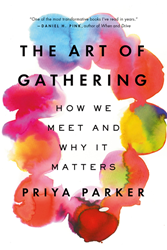The Art of Gathering: How We Meet and Why It Matters
March 10, 2022
The pandemic has made clear how we can’t take for granted the moments we spend in the company of others. The Art of Gathering is, at its heart, a rallying cry for honoring the people we love and making those fleeting moments truly special.
 The Art of Gathering: How We Meet and Why It Matters by Priya Parker, Riverhead Books
The Art of Gathering: How We Meet and Why It Matters by Priya Parker, Riverhead Books
The way we gather matters.
Though published two years before the initial outbreak of COVID-19 in the United States, the opening line of Priya Parker’s The Art of Gathering feels uncannily relevant to the new pandemic normal. Gatherings continue to be a part of daily lives, even with the pandemic still raging. The difference, however, has been that our mental templates of what any given social gathering could be are no longer valid. Where does that leave us?
Fortunately, The Art of Gathering serves as a survival handbook for those looking to make the most of our shared spaces in this new normal. In an unprecedented era where we can rewrite the rules of what it means to gather, Parker gives us the tools we need to create transformative gatherings that "dazzle."
Parker kicks off the first chapter asking, “Why do we gather?”
She brings to light the idea of event categories and how “we often let old or faulty assumptions about why we gather dictate the form of our gatherings." A workday is filled with endless meetings because, well, what is a workday without them? A baby shower’s guest list is limited to women only because, well, that’s how it’s always been. The events fail to inspire us because they’re guided by preconceived notions and shaped by logistics rather than addressing the needs and values of the collective.
Early on, Parker gives some practical frameworks to help us create better gatherings such as drill, baby, drill, which helps draw out the deeper meaning of gathering in a way not unlike explaining something new to an inquisitive toddler. Parker writes:
Let’s look at how we might move from the what to the why of something as simple as a neighborhood potluck.
Why are you having a neighborhood potluck?
Because we like potlucks, and we have one every year.
Why do you have one every year?
Because we like to get our neighbors together at the beginning of the summer.
Why do you like to get your neighbors together at the beginning of the summer?
I guess, if you really think about it, it’s a way of marking the time and reconnecting after the hectic school year.
Aha.
And why is that important?
Because when we have more time in the summer to be together, it’s when we remember what community is, and it helps us forge the bonds that make this a great place to live. Aha. And safer. Aha. And a place that embodies the values we want our children to grow up with, like that strangers aren’t scary. Aha. Now we’re getting somewhere.
By using this intentional line of questioning, Parker demonstrates how any given gathering can move away from being generic and unremarkable to distinct and memorable. The details needed to pull off the event—the venue, the activities, who gets invited, and so on—fall into place more easily once the greater purpose is there to guide the process.
Parker's methods for creating better gatherings have been tested in her experience as a conflict resolution facilitator. The frameworks are thought-provoking and gently push the reader beyond their comfort zone. For example, Parker deconstructs the idea of being all-inclusive, reasoning that placing limits on who gets invited honors the purpose of the gathering more than an open-door policy does. Ideas like these feel counterintuitive, but the book does a fine job of justifying the deconstruction of previous patterns by giving real-life examples of successful gatherings that have benefited from these methods.
The best part is how the book follows its own rules faithfully. Midway through the book, Parker notes that a good gathering will end on a clear high note, not with something mundane like announcements. Sure enough, in the final chapter, Parker places her author acknowledgments not at the end of the book, but just before it. The book thus ends on the line, “This gathering was different from all the others.”
And isn’t that how all gatherings should be?
The pandemic has made clear how we can’t take for granted the moments we spend in the company of others. The Art of Gathering is, at its heart, a rallying cry for honoring the people we love and making those fleeting moments truly special.



